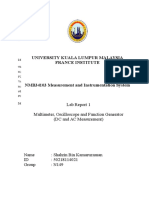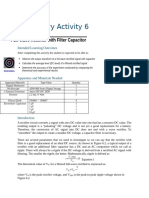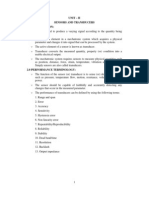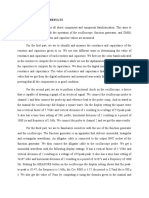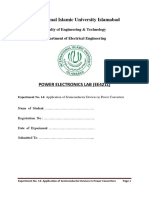International Islamic University, Islamabad: Faculty of Engineering and Technology
International Islamic University, Islamabad: Faculty of Engineering and Technology
Uploaded by
Lovely JuttCopyright:
Available Formats
International Islamic University, Islamabad: Faculty of Engineering and Technology
International Islamic University, Islamabad: Faculty of Engineering and Technology
Uploaded by
Lovely JuttOriginal Title
Copyright
Available Formats
Share this document
Did you find this document useful?
Is this content inappropriate?
Copyright:
Available Formats
International Islamic University, Islamabad: Faculty of Engineering and Technology
International Islamic University, Islamabad: Faculty of Engineering and Technology
Uploaded by
Lovely JuttCopyright:
Available Formats
International Islamic University, Islamabad
Faculty of Engineering and Technology
Department of Electrical Engineering
CIRCUIT ANALYSIS-II LAB (EE101L)
Experiment No. 1: AC and DC Circuits Measurement Techniques
Name of Student: ………………………………………
Registration No.: …………………………………………
Section: ………………………………………………………
Date of Experiment: ……………………………………
Marks Obtained: ………………………………………
Instructor’s Signature: ………………………………
Experiment No. 1: AC and DC Circuits Measurement Techniques Page 1
MEASUREMENTS TECHNIQUES
1. Objectives
(1) To measure the AC and DC amplitudes of a waveform with an Oscilloscope.
(2) To measure the AC and DC Amplitudes of a waveform with a Digital Millimeters.
(3) To measure the period and frequency of periodic waves with an Oscilloscope.
(4) To measure the phase shift between two sinusoidal waves with an Oscilloscope.
2. Equipment Required
Oscilloscope
Digital Multimeter (DMM)
DC Power Supply
Function generator
Resistors
(2) 1-kΩ
(1) 2-kΩ
(1) 3.9-kΩ
(2) 1-MΩ
Capacitor
0.1µF
THEORY
This experiment will be an introduction to the measuring instrumentation commonly used to
measure DC and AC quantities. Specifically, the oscilloscope and the digital millimeters will
be used to measure both the AC and DC components of a voltage waveform.
OSCILLOSCOPE
The oscilloscope is basically a voltage measuring device. It measures the amplitude of any
periodic voltage in terms of its peak-to-peak value. By contrast, the digital multimeter
measures the rms value of the periodic wave. Note, however, that some digital mulitmeters
measure the rms value of a sinusoidal wave only.
The oscilloscope can also be used to measure the period, and consequently the frequency, of a
periodic wave. In case of sine wave, it will measure the frequency of that wave; if a pulse is
applied, it will allow for the determination of its fundamental frequency. The frequencies
Experiment No. 1: AC and DC Circuits Measurement Techniques Page 2
determined from the oscilloscope measurements will be compared with those made with a
frequency counter.
It is important in the use of a particular measuring instrument to note its possible effect on the
measurements taken. To demonstrate this, a circuit is used which has low impedance as
compared to the input impedance of the oscilloscope. Thus, the circuit voltage measured
approaches its theoretical value. However, when the circuit impedance is changed, it nearly
approaches to that of the oscilloscope, serious measurement errors are introduced. To
overcome these errors, 10:1 test probes are used.
The screen is divided into centimeter division in the vertical and horizontal directions. The
vertical sensitivity is provided in volts/cm, while the horizontal scale is provided in time/cm.
If a particular signal occupies 6 vertical centimeters and the vertical sensitivity is 5mV/cm,
the magnitude of the signal can be determined from the following equation:
Signal voltage = [voltage sensitivity (V/cm) × Occupied Boxes (cm)] Vs = (5mV/cm) × (6cm)
= 30 mV
If one cycle of the same signal occupies 8 horizontal centimeters on the horizontal scale
with a horizontal sensitivity of 5us/m, the period and frequency of the signal can be determined
from the following equation:
Period of waveform = [horizontal sensitivity (s/cm) × Boxes occupied by 1 cycle (cm)] Time
Period = (5u/cm) (8cm) = 40 us
The instructor will provide a brief description of the various sections of the
oscilloscope and function generator. In your own words, describe the function and use of
each of the following and use of each of the following controls or sections of the
oscilloscope;
a) Focus
b) Intensity
Experiment No. 1: AC and DC Circuits Measurement Techniques Page 3
c) Beam finder
d) Vertical and Horizontal positions controls
e) Trigger section
f) Vertical sensitivity
g) Vertical mode selection
h) AC-GND-DC switch
i) Horizontal Sensitivity
j) Calibrate switch
k) Probe
FUNCTION GENERATOR
The Function Generator is a supply that typically provides a sinusoidal, square-
wave, and triangular waveform for a range of frequencies and amplitudes. Although the
frequency of the function generator can be set by the dial position and appropriate multiplier,
the oscilloscope can be used to precisely set the output frequency. The scope can also be
used to set the amplitude of the function generator since most function generators simply
have an amplitude control with no level indicators.
Experiment No. 1: AC and DC Circuits Measurement Techniques Page 4
PROCEDURE
Part 1: AC and DC Voltage Amplitude Measurements
a. Construct the circuit of Fig. 1-1. Insert the measured resistor values.
R1(meas)=_______, R2(meas)=_______, R3(meas)=_______
b. Connect the oscilloscope to measure the voltage Vi. For the channel being used set the
AC-GND-DC switch to GND position and set the horizontal line in the middle of the screen.
Then return the AC-GND-DC switch to AC position.
c. Set the vertical sensitivity to 1 V/cm and adjust the amplitude control of the signal
generator until Vi=8Vp-p at a frequency of 1 kHz. Use a horizontal sensitivity of 0.2 ms/cm.
Fig. 1-1
d. Set the DC supply to 12V using DMM. The network is now established with both AC
and DC supply.
DC MEASUREMENTS
Both the oscilloscope and DMM will now be used to measure the DC Levels of Fig. 1-1.
e. Calculate the expected DC voltage level at V0 using the measured resistors values.
(Calculated) V 0=¿ __________
Experiment No. 1: AC and DC Circuits Measurement Techniques Page 5
f. Use the DMM to measure the DC level of V0:
(Measured) V 0=¿ __________
Determine the percentage difference between the calculated and measured values using the
following equation.
(│ V 0 (cal)−V 0 (meas)│)
% Difference= ∗100 % (1.1)
│ V 0 (cal)│
=
g. Connect the scope to V0 and set the AC-GND-DC switch to the DC position. Using a
sensitivity of 1 V /cm determines the shift (in volts) in the positive peak value (referenced to
0V) from the established in part 1(c).
(Measured) shift in V0= ________________
Is the scope or DMM more accurate for this type of reading? Why?
AC MEASUREMENTS
Both the oscilloscope and DMM will now be used to measure the AC levels of Fig. 1-1.
h. Calculate the rms value of the applied voltage Vi.
(Calculated) Vi (rms) = _____________
i. Calculate the expected rms voltage V0 for the network of Fig. 1-1 at a frequency of
1kHz, using measure resistor values. Be aware the reactance of the capacitor must be
determined and the vector relationship between resistive and reactive elements employed in
the determination. For the AC analysis the 12 V supply can be set to zero volts (superposition
applies to the DC/AC analysis of the network) resulting in a parallel arrangement for R 2 and
R3.
(Calculated) V0 (rms)= ______________
j. Use DMM to measure the rms value of V0.
(Measured) V0 (rms)= ______________
Experiment No. 1: AC and DC Circuits Measurement Techniques Page 6
Determine the percent difference between the calculated and measured values using Eq. 1.1
(Calculated) % difference= _________________
k. Connect the oscilloscope to measure V 0 and set the AC-GND-DC switch at the AC
position. Using an appropriate vertical and horizontal sensitivity determine the peak to peak
value of V0.
(Measured) V0 (p-p) = _______________
Calculate the rms value of V0
(Measured) V0 (rms) = _______________
Determine the percent difference between the calculated and measured values using Eq. 1.1
(Calculated)% Difference = _____________
1. Are you satisfied that both the oscilloscope and DMM can effectively measure the rms
values of sinusoidal waveforms? Why?
Part 2: Measurements of the periods and Fundamental Frequencies of
Periodic Waveforms
In this part of the experiment, the oscilloscope will be used to measure the period and
frequency of a sinusoidal waveform.
a. Hook up the signal generator directly to a vertical channel of the oscilloscope. Set the
frequency dial between 1 and 2 kHz without taking the time to carefully read the scale and
determine which frequency was chosen. Adjust the amplitude control unit until an 8V p-p signal
is obtained on the screen. An 8V p-p sinusoidal signal of unknown frequency is now displayed
to determine the period and frequency of a waveform.
Experiment No. 1: AC and DC Circuits Measurement Techniques Page 7
b. Adjust the horizontal sensitivity until 1 or 2 complete cycles of waveform is displayed
on the screen. Record the chosen horizontal sensitivity below.
Horizontal sensitivity = ________________
c. Measure the number of divisions (including fractional parts) encompassed by one full
cycle of the waveform on the screen.
Number of divisions = ______________
d. Calculate the period of the waveform by multiplying the horizontal sensitivity by the
number of divisions.
Period (T) = ____________
e. The frequency can be determined using the relationshipf =1/T . Calculate the
frequency.
Frequency (f) = ____________
f. Now the frequency is known compare it to the frequency set on the signal generator.
Record the set frequency below.
f (dial setting) = ___________
Part 3: Phase Shift Measurements
a. Construct the network of Fig. 1-2. insert the measured resistor value
R(meas)=_____________
Fig 1-2
b. Determine the rms value of the 6Vp-p signal applied to the input.
(Calculated) Vi (rms) = _____________
c. Assume ∠ V 0 >∠ V i at the frequency of 1kHz
(Calculated)V0 (rms) = ____________
Experiment No. 1: AC and DC Circuits Measurement Techniques Page 8
(Calculated)V0 (p-p) = ____________
θ = ____________
the angle θ is the phase angle between Vi and V0.
d. Hook up Vi to channel 1 of the oscilloscope and establish V i as a 6Vp-p 1 kHz
sinusoidal signal balanced (using the AC-GND-DC switch) above and below the center line
on the screen using a vertical sensitivity of 1 V/cm.
e. Hookup channel 2 to V0 and using the same vertical sensitivity of 1 V/cm and
superimpose V0 on Vi Be sure both Vi and V0 are balanced above and below the center line
using the GND position of the AC-GND-DC switch for each channel.
f. Count the number of horizontal divisions between positive slopes of V0 and Vi as
shown in Fig. 1.3 and label the result A. the separation A represents the phase shift between
V0 and Vi.
A (number of divisions) = _____________
g. Count the number of divisions encompassed by one full cycle of the waveforms and
label the result B
B (number of divisions) = ____________
h. The phase angle in the degrees can then be determined using the following equation:
Ө=( A /B)∗36 0 0 (1.2)
using Eq. 1.2 calculate the phase angle between Vo and Vi for the network of Fig. 1-2
i. How does the phase angle measured in part 3(h) compare to the phase angle calculated
in part 3 (c)?
j. If V0 crosses the axis with a positive slope to the right of Vi, V0 lags Vi by the angle θ.
For the network of Fig. 1-2 does V0 lead or lag Vi is the result expected? Why?
k. The relationship between Vi and Vr can be obtained by interchanging the positions of
the capacitor and resistor. The change in location is required to ensure a common ground
between waveforms viewed on the scope
Experiment No. 1: AC and DC Circuits Measurement Techniques Page 9
Interchange the positions of the resistor and capacitor of Fig. 1-2 and calculate the magnitude
and angle of Vr assuming Vi= 0o
(Calculated) Vr (rms) = ____________
(Calculated) Vr (p-p) = ____________
θ = ____________
l. Use the oscilloscope to measure the magnitude of V0 and Vi also indicate if V0 leads or
lags Vi.
(measured) Vr (p-p) = __________
(measured) Vi (p-p) = __________
θ = __________
Lead or lag? = __________
How do the measured and calculated results compare?
(Measure) Vo (p.p) = __________
How do the results of part 4(c) and 4 (d) compare?
Experiment No. 1: AC and DC Circuits Measurement Techniques Page 10
You might also like
- Auto Transformer StarterDocument9 pagesAuto Transformer Starterdiana100% (3)
- Experiment1-Multimeter, Oscilloscope and Function GeneratorDocument11 pagesExperiment1-Multimeter, Oscilloscope and Function GeneratorHilmi SulimanNo ratings yet
- EP10 Operation of A Cathode Ray Oscilloscope (CRO)Document4 pagesEP10 Operation of A Cathode Ray Oscilloscope (CRO)Kw ChanNo ratings yet
- Nidhi EM Numerical - Examples - For - TestsDocument10 pagesNidhi EM Numerical - Examples - For - Testsapi-26910047No ratings yet
- LAB 13-PE-LabDocument6 pagesLAB 13-PE-LabLovely JuttNo ratings yet
- Lab ReportDocument12 pagesLab ReportSarah HarunNo ratings yet
- Exp 3 Oscilloscope and Voltage MeasurementDocument7 pagesExp 3 Oscilloscope and Voltage MeasurementusmpowerlabNo ratings yet
- Department of Electrical Engineering: Faculty Member: - DatedDocument11 pagesDepartment of Electrical Engineering: Faculty Member: - DatedShabir AhmadNo ratings yet
- Experiment Reportexample PDFDocument16 pagesExperiment Reportexample PDFJacintha BridgewaterNo ratings yet
- Experiment 1 - AC MeasurementDocument7 pagesExperiment 1 - AC MeasurementmixchescakeNo ratings yet
- Laboratory Activity 6Document6 pagesLaboratory Activity 6John Mark D. RoaNo ratings yet
- Cathode Ray Oscilloscope ExperimentDocument10 pagesCathode Ray Oscilloscope ExperimentHenok BelaynehNo ratings yet
- College Name: Measurement and Instrumentation (Ec 305)Document29 pagesCollege Name: Measurement and Instrumentation (Ec 305)Tiro RamatlakadibeNo ratings yet
- ECE 140 L C: Inear IrcuitsDocument10 pagesECE 140 L C: Inear IrcuitsPaola RamírezNo ratings yet
- Experiment No.2 Half-Wave and Full-Wave Rectification ObjectivesDocument3 pagesExperiment No.2 Half-Wave and Full-Wave Rectification ObjectivesJhun Michael LocusNo ratings yet
- Practicas de OsciloscopioDocument9 pagesPracticas de OsciloscopiokarolcoNo ratings yet
- 23-200-0208b - Basic Electronics Lab Manual - NewDocument43 pages23-200-0208b - Basic Electronics Lab Manual - Newsooryakiran347No ratings yet
- 10 Oscope Proc SPR 2011 PDFDocument3 pages10 Oscope Proc SPR 2011 PDFShamoon WahedNo ratings yet
- Experiment No 1Document13 pagesExperiment No 1Norman ElizagaNo ratings yet
- ELECS 1 Experiment #3Document20 pagesELECS 1 Experiment #3Aldrin ManeseNo ratings yet
- Yeditepe University Department of Electrical and Electronics Engineering Ee 232 Introduction To ElectronicsDocument5 pagesYeditepe University Department of Electrical and Electronics Engineering Ee 232 Introduction To Electronicstarafe5509No ratings yet
- EDC Lab Journal 25092024 100045amDocument108 pagesEDC Lab Journal 25092024 100045amhaseeb.chohan04No ratings yet
- Experiment 1 FamiliarizationDocument7 pagesExperiment 1 FamiliarizationSeif-El-Islam BayNo ratings yet
- Experiment 6Document11 pagesExperiment 6mohammad alaliNo ratings yet
- Student ManualDocument61 pagesStudent ManualCookiesNo ratings yet
- Microwave Lab-Manual (B.tech 2014)Document54 pagesMicrowave Lab-Manual (B.tech 2014)Ashish MangalNo ratings yet
- Experiment 2 Half Wave RectifierDocument5 pagesExperiment 2 Half Wave RectifierNasser AlyoubiNo ratings yet
- Lab 7 TransducersDocument14 pagesLab 7 Transducers27189No ratings yet
- CRO Controls From The Front PanelDocument6 pagesCRO Controls From The Front PanelVarunKumar100% (1)
- Me170a - Lab 01 - Instrumentation Handout - Edited2015Document8 pagesMe170a - Lab 01 - Instrumentation Handout - Edited2015andman753No ratings yet
- Lab 2: I-V Characteristics of Diodes: Waveform DisplayDocument6 pagesLab 2: I-V Characteristics of Diodes: Waveform DisplaywipernextNo ratings yet
- MDC Sem 2 - MergedDocument16 pagesMDC Sem 2 - Mergedtomar.anilkumarNo ratings yet
- EEE 124 Exp5Document4 pagesEEE 124 Exp5Rakibul Hassan SajonNo ratings yet
- VoltmetersDocument35 pagesVoltmetersjunaydNo ratings yet
- Measurement ElectricityDocument4 pagesMeasurement ElectricityMd HamzaNo ratings yet
- Instrumentation Lab ManualDocument14 pagesInstrumentation Lab ManualAmulyaNo ratings yet
- Lab ManualDocument17 pagesLab ManualMUHAMMAD UTHMAN SYAFI'IE MOHD SALEHNo ratings yet
- ICS Lab ManualDocument28 pagesICS Lab Manualashok_abclNo ratings yet
- Faculty ManualDocument60 pagesFaculty ManualCookiesNo ratings yet
- Lab 2: AC Measurements-Capacitors and Inductors: Prerequisite Reference MaterialsDocument10 pagesLab 2: AC Measurements-Capacitors and Inductors: Prerequisite Reference MaterialsLeandro ArvattiNo ratings yet
- Interpretation of ResultsDocument2 pagesInterpretation of ResultsKevin Luis Markus PinedaNo ratings yet
- Industrial Electronics: College of Engineering and Architecture - Electronics Engineering DepartmentDocument7 pagesIndustrial Electronics: College of Engineering and Architecture - Electronics Engineering DepartmentKarl Vincent BebingNo ratings yet
- Lab III ReportDocument16 pagesLab III ReportBenard MusondaNo ratings yet
- UNIT 2 MechatronicsDocument35 pagesUNIT 2 MechatronicsMuthuvel M91% (11)
- TN22 Vibration Sensor Wiring and Cabling 2018Document8 pagesTN22 Vibration Sensor Wiring and Cabling 2018adigesimurgNo ratings yet
- Interpretation of ResultsDocument3 pagesInterpretation of ResultsJulian CaminaNo ratings yet
- Multimeter GUIDELINEDocument14 pagesMultimeter GUIDELINEAmirul SyazwanNo ratings yet
- EC01 MultimetersDocument4 pagesEC01 MultimetersSchool BackupNo ratings yet
- Lab 5 Function Generator and OscilloscopeDocument4 pagesLab 5 Function Generator and OscilloscopeRaquel Jimena Rey PradaNo ratings yet
- MEC320P Sensors and Control Engineering Practice: Lab ManualDocument72 pagesMEC320P Sensors and Control Engineering Practice: Lab ManualAnonymous JZqXJ1IqjNo ratings yet
- Oscilloscope Voltage Measurements: Department of Electrical Engineering - CEAT, UP Los BañosDocument4 pagesOscilloscope Voltage Measurements: Department of Electrical Engineering - CEAT, UP Los BañosSagnale UnnoNo ratings yet
- Lab 1 Introduction To Workbench Apparatus: ObjectiveDocument51 pagesLab 1 Introduction To Workbench Apparatus: ObjectiveOsama Ahmed OfficialNo ratings yet
- Electric Circuits I: Laboratory Guide ForDocument67 pagesElectric Circuits I: Laboratory Guide ForMisa KurobaneNo ratings yet
- Lab Report 2Document9 pagesLab Report 2tom0% (1)
- Cathode Ray Oscilloscope - For TeachersDocument31 pagesCathode Ray Oscilloscope - For TeachersRaja Inayat docsNo ratings yet
- Lab4 1731806039055Document7 pagesLab4 1731806039055J.v KrishnaNo ratings yet
- Measurement of Amplitude, Time Period and Frequency Using CroDocument8 pagesMeasurement of Amplitude, Time Period and Frequency Using Crodhanisha100% (1)
- 2255-1 ManualDocument6 pages2255-1 Manualgloriyeah2003No ratings yet
- Amplifier Characterization: Fundamentals of Electrical and Electronic Systems. Lab 1Document4 pagesAmplifier Characterization: Fundamentals of Electrical and Electronic Systems. Lab 1Andrea Dwight CostanzoNo ratings yet
- Experiment No. 1Document8 pagesExperiment No. 1Rhea FayeNo ratings yet
- AC Circuits LAB 1Document4 pagesAC Circuits LAB 1sarsm56No ratings yet
- Design of Electrical Circuits using Engineering Software ToolsFrom EverandDesign of Electrical Circuits using Engineering Software ToolsNo ratings yet
- Lab 8-CS-LabDocument5 pagesLab 8-CS-LabLovely JuttNo ratings yet
- LAB 8-PE-LabDocument12 pagesLAB 8-PE-LabLovely JuttNo ratings yet
- LAB 11-PE-LabDocument10 pagesLAB 11-PE-LabLovely JuttNo ratings yet
- Lab 4-CS-LabDocument15 pagesLab 4-CS-LabLovely JuttNo ratings yet
- Lab 1-CS-LabDocument18 pagesLab 1-CS-LabLovely JuttNo ratings yet
- LAB 4-PE-LabDocument7 pagesLAB 4-PE-LabLovely JuttNo ratings yet
- LAB 14-PE-LabDocument4 pagesLAB 14-PE-LabLovely JuttNo ratings yet
- Lab 2-CS-Lab-2020Document12 pagesLab 2-CS-Lab-2020Lovely JuttNo ratings yet
- LAB 12-PE-LabDocument9 pagesLAB 12-PE-LabLovely JuttNo ratings yet
- LAB 5-PE-LabDocument7 pagesLAB 5-PE-LabLovely JuttNo ratings yet
- LAB 3-PE-LabDocument8 pagesLAB 3-PE-LabLovely JuttNo ratings yet
- LAB 1-PE-LabDocument10 pagesLAB 1-PE-LabLovely JuttNo ratings yet
- Digital Logic Design: Laboratory ManualDocument7 pagesDigital Logic Design: Laboratory ManualLovely Jutt0% (1)
- LAB 2-PE-LabDocument9 pagesLAB 2-PE-LabLovely JuttNo ratings yet
- Lab # 01: Familiarization To ProteusDocument13 pagesLab # 01: Familiarization To ProteusLovely JuttNo ratings yet
- A A A A: Const ConstDocument2 pagesA A A A: Const ConstLovely JuttNo ratings yet
- Lab 09Document2 pagesLab 09Lovely JuttNo ratings yet
- Object Oriented Programming Lab 01 Topic Covered: Classes and ObjectsDocument2 pagesObject Oriented Programming Lab 01 Topic Covered: Classes and ObjectsLovely JuttNo ratings yet
- Object Oriented Programming Lab 11 Topic Covered: Inheritance FIFO (First in First Out)Document1 pageObject Oriented Programming Lab 11 Topic Covered: Inheritance FIFO (First in First Out)Lovely JuttNo ratings yet
- Object Oriented Programming Lab 03 Topic Covered: Constructor and DestructorDocument2 pagesObject Oriented Programming Lab 03 Topic Covered: Constructor and DestructorLovely JuttNo ratings yet
- Publication That Stores The Title (A Char Array) and PriceDocument1 pagePublication That Stores The Title (A Char Array) and PriceLovely JuttNo ratings yet
- TN System - Protection Against Indirect Contact - Electrical Installation GuideDocument4 pagesTN System - Protection Against Indirect Contact - Electrical Installation GuideRajendra Prasad ShuklaNo ratings yet
- 1.1 Earthing Transformers: 1.1.1 Construction and RatingDocument7 pages1.1 Earthing Transformers: 1.1.1 Construction and RatingSohail Hasan100% (1)
- LRC Circuits Resonances - George Ricarrson 2501987261Document14 pagesLRC Circuits Resonances - George Ricarrson 2501987261George RY100% (1)
- Nitrogen in TransformersDocument22 pagesNitrogen in TransformersEdwin Cob GuriNo ratings yet
- Measuring Up An Audio Transformer - Norman H. Crowhurst (Audio Engineering, Nov 1952)Document4 pagesMeasuring Up An Audio Transformer - Norman H. Crowhurst (Audio Engineering, Nov 1952)jimmy67music100% (3)
- Design and Development of Mobile Phone JammerDocument6 pagesDesign and Development of Mobile Phone JammerAJER JOURNALNo ratings yet
- Advantages of Bundled Conductors in Transmission LinesDocument5 pagesAdvantages of Bundled Conductors in Transmission Linesf3ziii100% (1)
- Digital Automatic Voltage Regulator Operation and Maintenance ManualDocument454 pagesDigital Automatic Voltage Regulator Operation and Maintenance ManualNaresh Pattanaik100% (1)
- Tesla Project BookDocument21 pagesTesla Project BookNo ExperienceNo ratings yet
- The Effect of Lightning Impulse Characteristics and Line Arrester To The Lightning Protection Performance On 150 KV Overhead Lines ATP EMTP Computational ApproachDocument12 pagesThe Effect of Lightning Impulse Characteristics and Line Arrester To The Lightning Protection Performance On 150 KV Overhead Lines ATP EMTP Computational ApproachAnakrino MbidiNo ratings yet
- Experiment.3.SingleTunedAmp 22112016Document12 pagesExperiment.3.SingleTunedAmp 22112016Saurav kumarNo ratings yet
- Modern Power System Protective Relay REV04Document440 pagesModern Power System Protective Relay REV04Osman Ahmed100% (5)
- Engineering Science - DC and AC TheoryDocument15 pagesEngineering Science - DC and AC TheorySteven Goddard75% (4)
- (Semester-I & II) Engineering Mathematics - I: Time: 2 Hours) (Max. Marks: 70 Instructions To The CandidatesDocument66 pages(Semester-I & II) Engineering Mathematics - I: Time: 2 Hours) (Max. Marks: 70 Instructions To The CandidatesOnkar LondheNo ratings yet
- Electric Circuit Theory Syllabus (ECE)Document2 pagesElectric Circuit Theory Syllabus (ECE)Rakesh KumarNo ratings yet
- 10 - Notes - Transformers Part IDocument6 pages10 - Notes - Transformers Part IWillam MetzNo ratings yet
- High Impedance FaultsDocument3 pagesHigh Impedance FaultsGary GrubbsNo ratings yet
- Basic Electrical Engineering by Pawan Chandani Sir 1679927943592-UnlockDocument27 pagesBasic Electrical Engineering by Pawan Chandani Sir 1679927943592-UnlockSunnu MauryaNo ratings yet
- Superimposed Component Based Directional RelayingDocument12 pagesSuperimposed Component Based Directional RelayingsrifaceNo ratings yet
- Assignment 2Document3 pagesAssignment 2Mashood NasirNo ratings yet
- A Novel Four-Arm Planar Spiral Antenna For GNSS ApplicationDocument8 pagesA Novel Four-Arm Planar Spiral Antenna For GNSS ApplicationRifaqat HussainNo ratings yet
- Lessons in Electric Circuit1Document51 pagesLessons in Electric Circuit1jun dee100% (2)
- What Is The Difference Between A Decoupling Capacitor and A Bypass CapacitorDocument16 pagesWhat Is The Difference Between A Decoupling Capacitor and A Bypass CapacitorjackNo ratings yet
- 2-Channel Unit SUB - SUB 2x400ohm 6ch User ManualDocument130 pages2-Channel Unit SUB - SUB 2x400ohm 6ch User Manualhui liuNo ratings yet
- DTC 19300Document8 pagesDTC 19300Rafael Ricardo Zacarias CastilloNo ratings yet
- 4453imguf - AI I YearDocument21 pages4453imguf - AI I Yearsamreenm567No ratings yet
- UNIT 1 Overvoltages and Insulation CoordinationDocument19 pagesUNIT 1 Overvoltages and Insulation CoordinationhaidaryhalunaNo ratings yet
- Characterization of ComponentsDocument0 pagesCharacterization of ComponentsCristian MorariNo ratings yet

